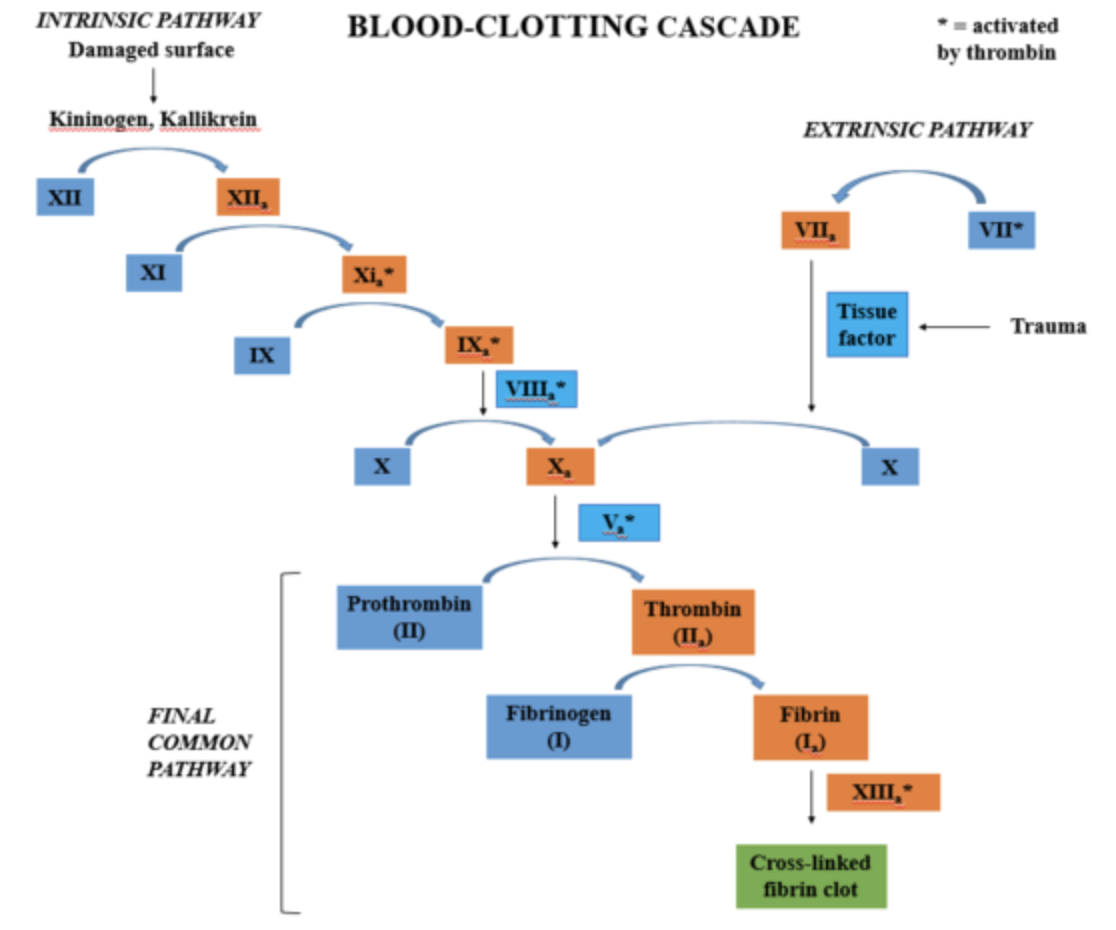Answer
371.1k+ views
Hint: The process of blood clotting or blood coagulation occurs when there is any damage to the blood vessels in order to stop the loss of blood from the body before shock and possible death may occur. Clotting is done by converting liquid blood to solid gel-like to prevent its flow.
Complete Answer:
Blood clotting is a mechanism to prevent excessive loss of blood from the body. A clot or coagulum is formed as the place of injury to act as a plug to prevent the flow of blood outside. This coagulum is formed by a network of threads known as fibrins which are converted from inactive fibrinogen to active fibrins by the enzyme thrombin.

Thrombin is again converted from inactive prothrombin by the enzyme thrombokinase and calcium ions. This prothrombin is produced by platelets in the presence of vitamin K. Hence, the process of blood clotting does not require sodium ions.
Additional information: Let us know more about the process of blood clotting.
- The process of blood clotting takes place in a series of reactions known as the cascade process.
- The cascade process consists of two pathways known as the intrinsic pathway and the extrinsic pathway.
- The intrinsic pathway is initiated by Hageman’s factor or factor XII when there is damage within the walls of the blood vessels. The factors for this pathway are released by platelets and endothelium of blood vessels.
- The extrinsic pathway is initiated by the release of factors from the damaged tissue. This is because the cells of the damaged tissue show a surface protein known as tissue factor.
So, the correct option is ‘(a) Sodium ions’.
Note:
- The body contains 13 clotting factors for the process of blood coagulation.
- Fibrinogen is known as factor 1, prothrombin is known as factor 2, thromboplastin is factor 3, and calcium ions are factor 4.
- Deficiency of vitamin K in the body can affect the coagulation process and one tiny cut can result in the death of the person. Subject: Biology
Complete Answer:
Blood clotting is a mechanism to prevent excessive loss of blood from the body. A clot or coagulum is formed as the place of injury to act as a plug to prevent the flow of blood outside. This coagulum is formed by a network of threads known as fibrins which are converted from inactive fibrinogen to active fibrins by the enzyme thrombin.

Thrombin is again converted from inactive prothrombin by the enzyme thrombokinase and calcium ions. This prothrombin is produced by platelets in the presence of vitamin K. Hence, the process of blood clotting does not require sodium ions.
Additional information: Let us know more about the process of blood clotting.
- The process of blood clotting takes place in a series of reactions known as the cascade process.
- The cascade process consists of two pathways known as the intrinsic pathway and the extrinsic pathway.
- The intrinsic pathway is initiated by Hageman’s factor or factor XII when there is damage within the walls of the blood vessels. The factors for this pathway are released by platelets and endothelium of blood vessels.
- The extrinsic pathway is initiated by the release of factors from the damaged tissue. This is because the cells of the damaged tissue show a surface protein known as tissue factor.
So, the correct option is ‘(a) Sodium ions’.
Note:
- The body contains 13 clotting factors for the process of blood coagulation.
- Fibrinogen is known as factor 1, prothrombin is known as factor 2, thromboplastin is factor 3, and calcium ions are factor 4.
- Deficiency of vitamin K in the body can affect the coagulation process and one tiny cut can result in the death of the person. Subject: Biology
Recently Updated Pages
How do you arrange NH4 + BF3 H2O C2H2 in increasing class 11 chemistry CBSE

Is H mCT and q mCT the same thing If so which is more class 11 chemistry CBSE

What are the possible quantum number for the last outermost class 11 chemistry CBSE

Is C2 paramagnetic or diamagnetic class 11 chemistry CBSE

What happens when entropy reaches maximum class 11 chemistry JEE_Main

Calculate the volume occupied by 88 gram of CO2 at class 11 chemistry CBSE

Trending doubts
Difference Between Plant Cell and Animal Cell

Difference between Prokaryotic cell and Eukaryotic class 11 biology CBSE

Fill the blanks with the suitable prepositions 1 The class 9 english CBSE

Fill the blanks with proper collective nouns 1 A of class 10 english CBSE

Change the following sentences into negative and interrogative class 10 english CBSE

Select the word that is correctly spelled a Twelveth class 10 english CBSE

What organs are located on the left side of your body class 11 biology CBSE

What is the z value for a 90 95 and 99 percent confidence class 11 maths CBSE

Give 10 examples for herbs , shrubs , climbers , creepers



